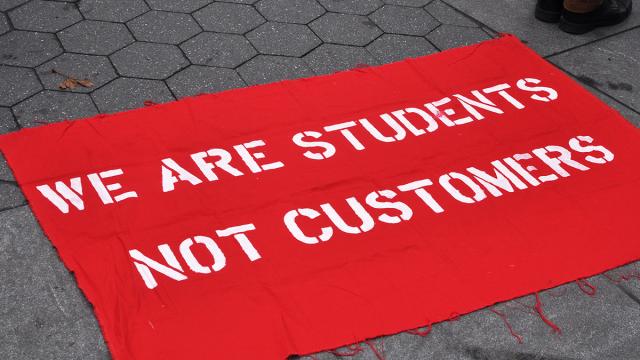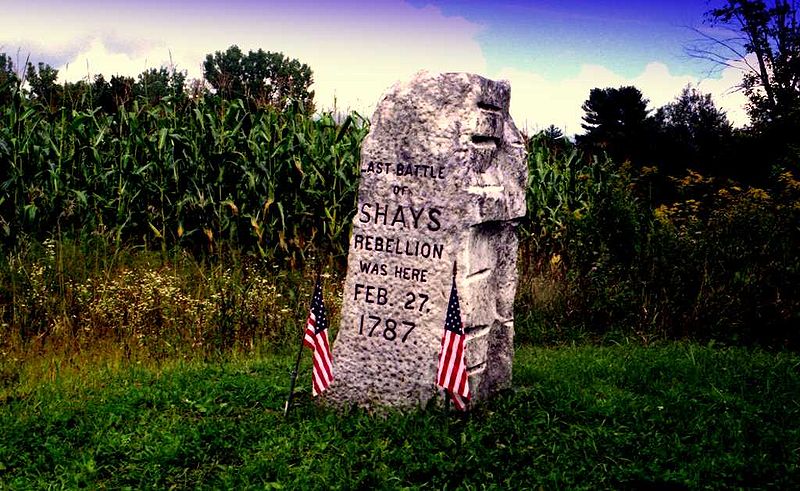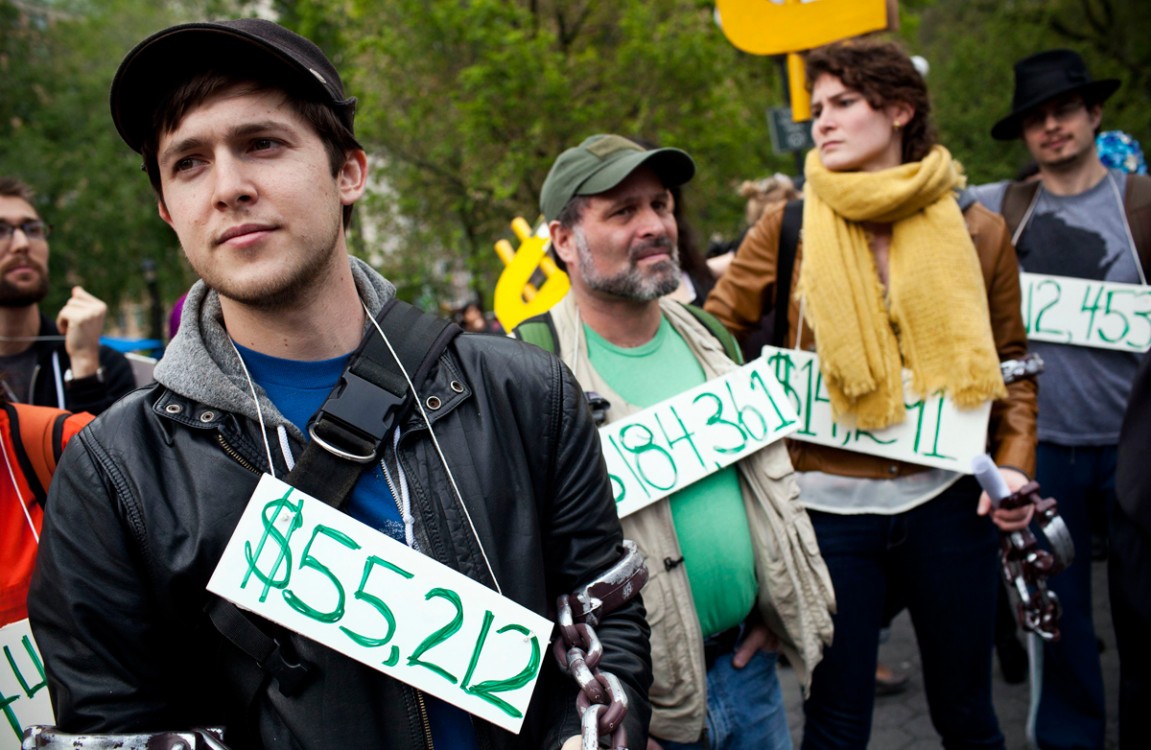
An active debt resistance movement is seizing hold across the United States. Currently, the debt strikers number over 100 students who are refusing to pay back the student loans they borrowed to go to the now-defunct for-profit Corinthian Colleges. The move has attracted media attention and could potentially provide a platform for a larger student debt movement to expand from here. However, students of history take note: this isn't the first time there have been debt resistance movements in the United States. And the lessons we learn from prior movements can just as easily be applied to today’s situation.
Shays’ Rebellion
Many people may not know much about Shays’ Rebellion, other than that it was a rebellion of farmers against the government. But the issue of debt was very much at the center of the conflict.
The rebellion resulted from post-Revolutionary War economics. After the war against Britain concluded, merchants here sought to expand their profits by trading with other regions, such as the Baltic states, Mediterranean and France. However, the Baltic wasn't so suitable as a trading partner because, while New England generally sent surplus grains, fish, and lumber abroad, these commodities were already produced in large quantity in the Baltics. The Mediterranean, meanwhile, was blocked off due to Barbary pirates attacking merchant ships. France was a no-go due to lack of credit.
The situation was made worse when American merchants attempted to trade with the British-controlled West Indies, and the British “excluded New England importers from the lucrative British West Indies market and left the Americans with few means to repay English merchants for the commodities they had purchased.” The West Indies situation, in the context of today's student debt crisis, is extremely important. Here's why.
Immediately following the Revolutionary War, British traders continued their prewar practice of selling big cargoes to American merchants on credit. U.S. merchants took out large loans from the British with the assumption that that they would be able to take advantage of the West Indies market and make enough money to pay off their debts that way. But when this payoff proved impossible, their economic situation turned dire. Merchants who defaulted on their loans could face severe repercussions – not just with regards to trade with the British, but also domestically.
In order to continue with their business, the merchants pressed shopkeepers to whom they'd loaned funds, and the shopkeepers in turn pressed farmers to pay back their loans. Most farmers were used to paying back their debts with crops rather than cash; they didn't have much cash on hand. This quickly landed many farmers in court with their land at stake, or simply in debtors prisons. The shopkeepers grew desperate, and tensions heightened between the urban middle-class merchants and the poor farmers.
A Rebellion Builds
As a response to the crisis, New England farmers began to organize and resist their debt burdens. The first order of business: to push for reform, via town meetings and county conventions, in favor of state-issued paper money and tender laws rather than the bullion coins used in that time. But this plan was rejected wholesale by elites and the business class. And since many New England legislators were located in coastal cities and needed the support of business, they too rejected the call for reform in 1785 and 1786.
Amidst the meetings, farmers also wrote petitions to their respective state governments. For example, in Massachusetts, between 1784 and 1787, yeomen in 73 rural Massachusetts towns sent petitions to the General Court of Boston; and in New Hampshire, according to documents from that time, from January 1784 to late September 1786, “yeomen in forty-one towns forwarded complaints to the state assembly.”
The tactics of the farmers began to take a turn in late 1786, as they saw their protests and petitions were doing virtually nothing to get the reforms they needed. At this point, the farmer protesters armed themselves “and proposed 'moderating government' by planned attacks upon the court system." The rebellion didn't last long. In Massachusetts, the governor called Congress to raise up forces and, though the state was only able to assemble 1,000 troops, the rebellion was quickly put down.
Resistance to Sharecropping
Almost 150 years later, another debt resistance movement took place, also centering on farmers and the oppression they felt at the hands of big business interests. However, the tactics they used this time were different – in good part due to union support.
Sharecropping is something that, along with convict leasing, is rarely mentioned in many U.S. history classes. The general myth is that after the Civil War ended, slavery ended with the passing of the 13th Amendment. The reality, though, is quite different. The oppression of African-Americans didn't end, but rather took the form of convict leasing and also sharecropping.
Sharecropping was essentially debt slavery, and as M. Langley Biegert notes in the Journal of Social History, many blacks thought that sharecropping was “often little better than the old system of slavery” and some even went so far as to “[argue] that it was even more dehumanizing than slavery.” In order to combat this post-War system, black and white sharecroppers alike began to organize.
In July of 1934 in Tyronza, Arkansas, 18 sharecroppers and tenant farmers met in a local schoolhouse to discuss the idea of forming a union for non-landowning farm workers. People at the time were being evicted from farms due to New Deal incentives to cut back on farm production. In response, workers decided to unite on a collective basis, and across racial boundaries, forming the Southern Tenant Farmers Union.
This wasn't an easy decision for many to make; the risk of retaliation was quite real, as in the case of former slave Bryant Singfield, who attempted to organize farm workers in Phillips County that were trying to negotiate their own new labor contracts. Singfield had been kicked off the plantation where he had worked as a slave due to his outspokenness. He then began to organize the former slaves who decided to stay on the plantation as contract workers.
He was quite successful, and some people felt emboldened enough to even go beyond the demand for collective bargaining. The angered planter class targeted Singfield who, along with other protesters, were rounded up by white planters and disappeared, never to be heard from again. However, members of the Union haad made their decision and quickly began agitating on behalf of workers. One of their notable early actions was the Missouri Sharecropper Demonstration in 1939.
Many sharecroppers and tenant farmers who worked in Missouri worked in the Bootheel region, prime real estate for cotton farming. However, in 1939, the U. S. Army Corps of Engineers announced it would breach the levee that had protected the region's richest cotton land. The government's decision aided the acceleration of getting rid of sharecroppers and tenants, and switching instead to day laborers and increased mechanization.
While the New Deal set up the Agricultural Adjustment Administration in order to provide checks to sharecroppers and tenant farmers, the checks were in fact given to planters who would often keep money and evict the workers. The final arbitrator of any disputes between planters and workers was settled by the county committees, which consistently sided with the planters.
In response, members of the Union engaged in wildcat cotton-picking strikes in the autumn of 1938. This in and of itself didn't do much to improve their case; however, it became a serious form of debt resistance because if the sharecroppers didn't work, they were unable to pay the debts they owed. Thus, by refusing to work, they were effectively engaging in an act of debt resistance.
Lessons Learned
Why does any of this matter? What are the lessons we can take from these movements that apply to today?
With regards to Shays' Rebellion, we can look at two things:
• The protesters had a clear, coherent message and stuck with it
• They escalated the situation over time.
With regards to a clear message, the best thing student debt activists can do today is to get on the same page with one another so that there is one, coherent message that gets repeated again and again. This will help serve as a guiding point for the goal that is to be achieved.
This means activists can up the ante and bring more attention to their cause by doing things like blocking roads and disrupting the status quo in a variety of peaceful, nonviolent ways. This can be see in the Black Lives Matter movement. In earlier times, farmers too engaged in a diversity of tactics. One lesson they can teach us: don't stop or slow down protesting just because negotiations with power holders have begun. Rather, negotiations are the time to increase the volume of the collective voice.
The sharecropping protests also remind us that while having leaders can be a good thing, it can also lead to targeting by the establishment – whether in terms of outright disappearance, as in the case of Singfield and his companions, or more typically in the form of cooptation. This is one argument currently used by people in favor of horizontal organizing.
A second lesson from the sharecropper and wildcat strikes is this: activists need to have each others' backs, meaning that when one group cries out for help, allies respond quickly and swiftly.
Finally, individual activists should be able to keep their autonomy and engage in actions that they see fit, while working within the broader, multi-organizational context of the conflict.
These lessons from the past may help the student debt movement as it seeks to allow people and groups to have their own autonomous voice and develop new protest tactics – all while staying on message and speaking with one common voice, one over-arching aim. Horizontal organizing, which seems quickly to be becoming the norm for current protests, mean there are less visible leaders to corrupt or attack, and makes sowing dissent and discord more difficult for authorities. But it also means that the message and focus of the movement runs the risk of dilution, with too many voices saying too many things at once.
If students are to win the fight for an education that doesn't leave them chained to decades of debt, they'll have to use every tool available. Including the lessons of history.
3 WAYS TO SHOW YOUR SUPPORT
- Log in to post comments
















